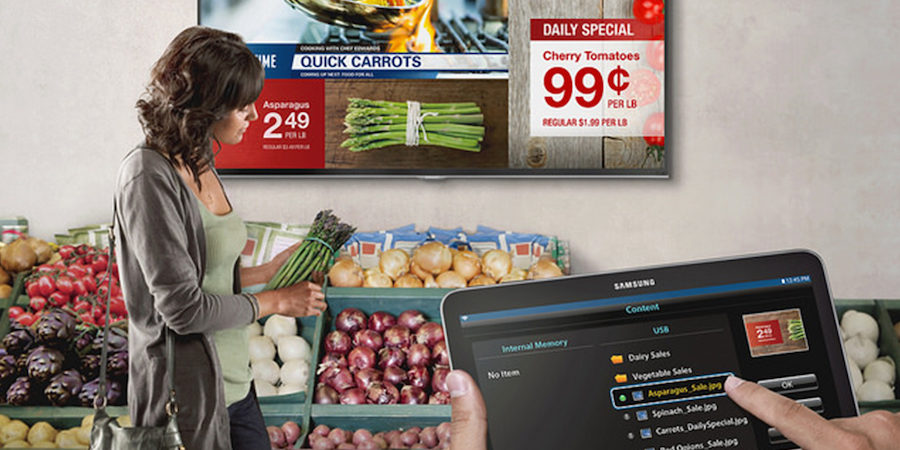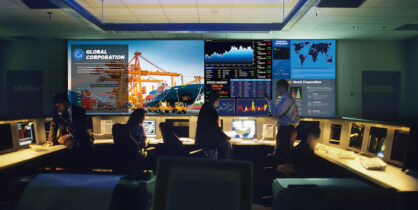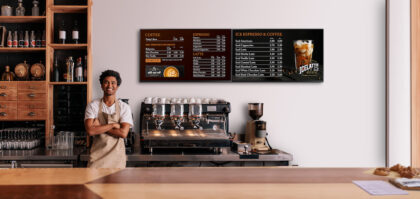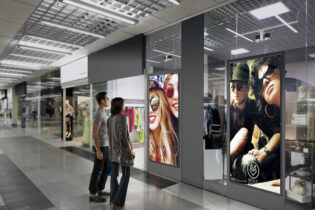The year 2020 will be known as a time when almost everything changed — from the way we work and shop to how we gather and move about. Positive change requires effective communication, and the steady evolution of our new normal has made digital signage technology even more relevant.
The way we interact publicly has become subject to steady transformation, and digital signage can help — displaying updated opening hours, access rules, capacity limits and even inventory for highly sought items.
Businesses that weren’t equipped with digital signage technology have had to resort to “hacks,” like handwritten notices and printouts taped to doors and walls. Businesses that already had digital signage in place are putting those screens to work, communicating changes quickly and easily.
Reducing contact
Many businesses and venues have been trying to become as contact-free as possible. Some of that involves limiting the need to touch things — like replacing manual doors with automatic ones. But the shift toward contactless operations is mostly about reducing face-to-face contact to mitigate health risks.
Digital transformation solutions for retail
Learn how to unify an omnichannel marketing strategy from the storefront to the point of sale in this webinar. Watch Webinar
Circumstances have elevated the idea of “untact” — an invented term that’s all about communicating effectively with customers, partners and colleagues while minimizing physical contact.
The untact concept manifests itself in sales calls, product demos and team meetings that used to be done in person but are now done via video conferencing. It’s also being applied in public settings — in retail, hospitality and other sectors — to drive customers to remote technology solutions that deliver services and facilitate transactions safely and effectively.
Same food, new normal
When you need a burger fix or a fancy coffee, you head to a quick service restaurant (QSR) operation. In 2020, closed or limited capacity dining areas have made drive-thrus mission-critical. What was already 70 percent of the revenue for some QSRs became 95 percent or even 100 percent of the business.
Digital signage is a huge part of drive-thrus, with QSR giants using presell and digital menu screens at more than 10,500 locations in the U.S. Rugged, outdoor-ready displays do the basics of relaying accurate, time-keyed ordering options, but they’re also powerful tools for promoting new items and specials.
Operators are starting to use artificial intelligence (AI) and anonymous camera-based sensors to analyze customer segments car by car and dynamically adjust menus to upsell and speed ordering decisions.
Self-serve ordering kiosks have also grown common in QSR, with touchscreen displays allowing for more order customization and lessening inaccurate orders and food waste. While touchscreens raise worries of transmitting contagions, QSR operators are counterbalancing that risk by doing regular, very visible cleaning and making sanitizers readily available.
Touchscreens minimize one-to-one contact risk. Workers do food prep behind the scenes and hand off packaged meals based on digital orders. While this may reduce the friendly, personal communications usually found in retail establishments, it’s prioritizing the health and safety of both staff and customers.
Local tech, remote management
Touchscreen kiosks have grown popular at airport check-in counters and customs areas because they speed lineups and ease some of the demands on staff. They also follow physical distancing guidelines by minimizing the need for counter staff to interact directly with other people.
Similar technologies that use screens and video conferencing to support remote tellers and customer service advisors have been trialed in places like banks and big box do-it-yourself stores, but rarely rolled out. Now, for retailers and other facilities that see a lot of foot traffic, digital signage screens that can deliver remote expertise and limit staff-customer contact are getting a second look.
Bright 4K screens, content management software, fast connections and crisp web cameras make it possible for a broad spectrum of retailers — from banking to hardware to home furnishings — to offer expert-level service and advice on the sales and service floor.
Single screens, narrow-bezel video walls and interactive displays like Samsung’s Flip 2 digital flip chart can enable valuable real-time conversations, demos and idea sessions — even when the retailer’s expert advisor is sitting in a home office in a different time zone.
New distance, same service
Physical distancing guidelines are requiring many retailers and other services to limit the numbers of visitors they have inside at any given time. The simple but labor-intensive fix is assigning staff to work as greeters, working in tandem with inside staff to signal when someone leaves, allowing the next person in line to enter.
Sensors — or more sophisticated on-site analytics systems — can do that work more cost-effectively. Sensors that scan lineups and active shopper density can trigger messaging on screens that function as metered traffic lights, signaling green when the next shopper can enter. The screens can also relay anticipated wait times.
Screens inside stores, in their windows and outside are also increasingly important. They can communicate changes in how the business is operating, like updated hours, cash handling, inventory levels or notifications for newly added services like curbside pickup.
Keeping up
There’s an old saying about the only constant in life being change, and that certainly applies these days. Technology is no different, constantly evolving into new iterations. In these times, leaning into the opportunities digital signage can provide for in-person experiences is change worth pursuing.
Discover the future of displays in retail environments in this free webinar, and see how super-bright outdoor displays can support drive-thru business.








